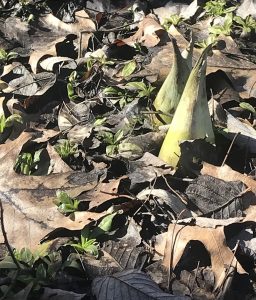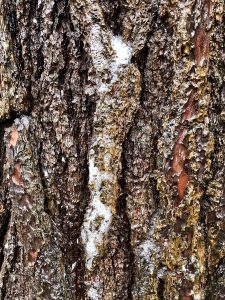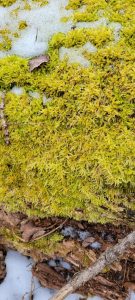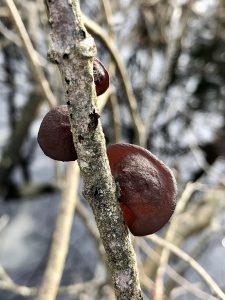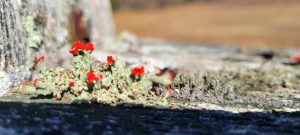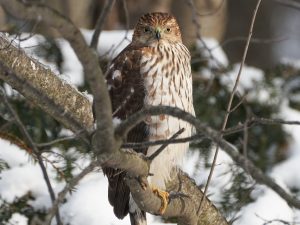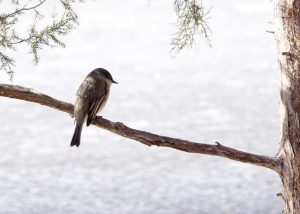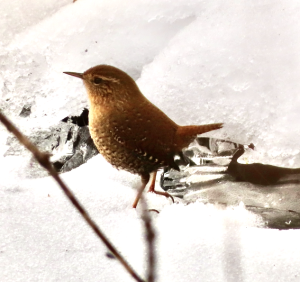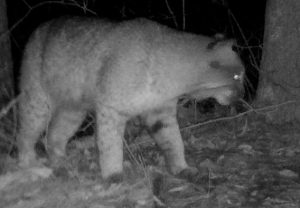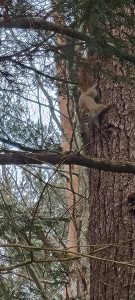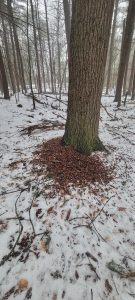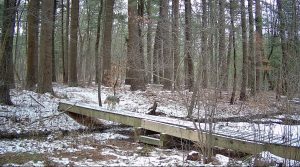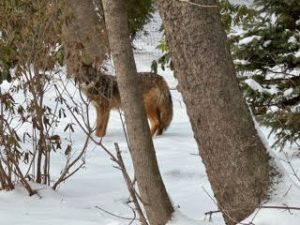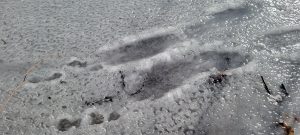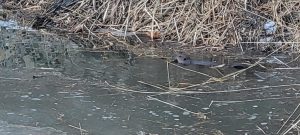Written by Gwyn Loud for the Lincoln Land Conservation Trust. She welcomes your sightings and questions at 781-259-8690 or gwynloud555@gmail.com
The past month has given us assorted weather, with periods of gloomy penetrating cold but more than one interlude of warmth, getting as high as 60℉ on Feb. 10. After several weeks of looking at bare ground, we had about an inch of snow on February 13, bringing white beauty to the landscape. If we believe groundhog folklore, spring will come early because Punxsutawney Phil (PA) did not see his shadow on Groundhog Day (Ms G, Massachusetts’ official groundhog at Drumlin Farm, was kept indoor for health reasons). As we know well, climate change is visible all around us. For example, Nan Bergen wrote, “We never used to start sugaring until March and there was normally still snow on the ground. The season lasted right into April. Now the sap starts to run as early as late January and the season is over at the beginning of March.” The ideal weather for sap collection is daytime temperatures about 40℉ and nighttime temperatures below freezing.
Skunk cabbage is poking up along streams and mosses provide bright green patches of color in the woods. Carol Roede photographed what looked like soapy bubbles on a big pine tree after rain, something I have also seen now and then, and she sent me an NPR link (see below) which explains what it is. Rebecca Roy, of Vermont State Parks, writes, “Salts and acids and alkali substances float in air, in dust. When it’s dry, these particles are floating around and sticking to surfaces all over the place. Tree bark produces oils, which are drawn to the surface of the bark in warm, dry weather. When it rains, these ingredients dissolve in the water and flow down the tree trunks. They start to bond chemically and create soap molecules. The rough surface of the bark helps to agitate the mixture — just like the friction created when you scrub a soapy dish in the sink — and by the time it gets to the bottom, the process has resulted in a little patch of soapy foam.”
A couple of moderate snow storms in January brought more birds to my feeders, which have not been as busy as in previous years. There seem to be plenty of dark-eyed juncos around; Rich Rosenbaum noticed juncos flying up into Shrubby St. John’s Wort plants and knocking seeds to the ground so they could eat them. Watching bird behavior is always interesting. Mixed flocks of red-winged blackbirds and brown-headed cowbirds are still here, having never left for southern climes. Recent sighting of birds such as Eastern towhees, hermit thrushes, pine warblers, Virginia rails, a field sparrow, a marsh wren, and an Eastern phoebe are further evidence that warmer winters are causing some birds to forgo migration. As long as they can find food, why not stay!
Bluebirds are busy inspecting bird houses and we now hear early spring song from cooing mourning doves, chattering house finches, and drumming woodpeckers. It is not nesting season for them yet, but they are getting ready to attract mates and establish territories. Golden-crowned kinglets have been numerous this winter and other avian reports include a fox sparrow, brown creepers, a yellow-bellied sapsucker, and a saw-whet owl was heard hooting. Carol Roede’s trail cam captured a screech owl swooping down to catch something to eat from the surface of a stream. Raptors seen include many red-tailed hawks, a sharp-shinned hawk, Cooper’s hawks, a Northern harrier, and a red-shouldered hawk, which I heard calling from woods where it has nested in prior years.
As I wrote last month, a citizen science project opportunity for birders, the annual Great Backyard Bird Count is coming up on Feb. 16-19. All you have to do is watch birds for 15 minutes or more at least once over the four days. Why not give it a try, all in the cause of contributing population data about our backyard birds? A link below gives instructions about counting and reporting.
February is a month when many of our common mammals are mating or bearing young. North American otters give birth to one to five young in February or March, with the young fully furred but with eyes closed and no teeth. After two months they are foraging with their mother and by next winter they will have established their own territories. This is the peak mating month for American beavers, which form permanent breeding pairs, mate in the water at night and give birth to three or four kits between May and July. Observers have noticed recently-felled trees, evidence of beavers’ hard work, around Beaver Pond and Mt. Misery ponds. In February raccoons emerge from their winter naps and promptly search for mates. Bobcats also breed this month, traveling great distances in the process. If you think you are smelling a skunk, it could be a red fox; their urine has a strong musky odor, smelling a lot like skunk spray. Many mammals mark territory and send messages through deposits of urine. As Mary Holland writes, “The strength of the odor of a fox’s urine during January and February is indicative of the important role urine plays in red fox courtship. Information as detailed as the marker’s sex, age, dominance status, and breeding status is conveyed via scent posts scattered throughout the fox’s territory as well as along its borders.”
Depending on the weather, the annual amphibian migration to vernal pools may occur before my March column reaches your inbox. If it is raining after dark and the temperature is 38℉ or warmer, spotted salamanders and wood frogs will feel the urge to move to the vernal ponds where they were born. This is an ancient migration and can be seen in various predictable places in Lincoln where the amphibians cross roads. American toads and spring peepers are part of the event as well, each species having its own time table. If you would like to volunteer to help record the migration, please fill out a Big Night Volunteer Application Form here: www.tinyurl.com/LincolnBigNightVolunteer. Because this type of activity involves walking along or on roadways in the dark, it is recommended that only adults participate. Please note, roads will not be closed and therefore there will be vehicular traffic to be mindful of.
Relevant links:
To learn about “soap bubbles” on tree trunks
Screech Owl in Swamp (Carol Roede’s Trail Cam)
To read how to participate in the Great Backyard Bird Count Feb.16-19


